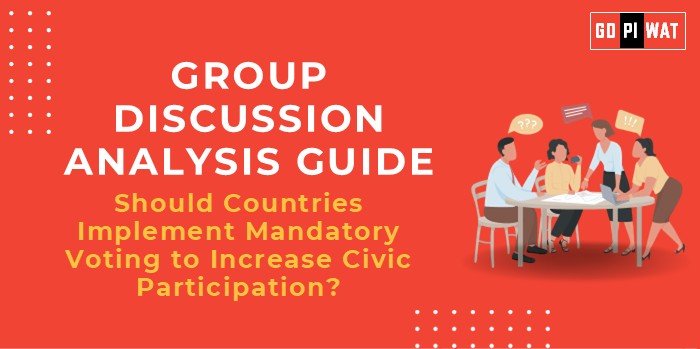📋 Group Discussion (GD) Analysis Guide: Should Countries Implement Mandatory Voting to Increase Civic Participation?
🌟 Introduction to Mandatory Voting
Opening Context: Voting is a cornerstone of democracy, yet declining voter turnout has become a global concern. Mandatory voting, as practiced in countries like Australia, sparks debates about its role in enhancing civic participation.
Topic Background: Originating in Belgium in 1893, mandatory voting aims to address political disengagement. By imposing a civic duty to vote, it seeks to ensure a more representative democracy. However, its implementation raises questions about individual freedoms and practical efficacy.
📊 Quick Facts and Key Statistics
- 🌍 Global Practices: 22 countries, including Australia and Brazil, enforce mandatory voting.
- 📈 Impact on Turnout: Australia achieved over 90% voter turnout post-1924 mandatory voting laws.
- 👩🎓 Youth Engagement: Countries with mandatory voting see a 20% higher youth participation rate on average.
- 📉 Decline in Democracies: Global voter turnout dropped from 79% (2000) to 68% (2023) in parliamentary elections.
👥 Stakeholders and Their Roles
- 🏛️ Government: Enforces policies, ensures voter awareness, and allocates resources for seamless execution.
- 🗳️ Political Parties: Mobilize voters and adapt strategies to engage diverse demographics.
- 👩👩👦👦 Citizens: Participate as responsible democratic actors while debating individual rights versus collective responsibility.
- 🌍 International Observers: Provide comparative analyses of mandatory voting systems and their outcomes.
✅ Achievements and Challenges
🏆 Achievements:
- 📈 Enhanced Participation: Countries like Belgium report a 30% rise in turnout since adopting mandatory voting.
- 🗳️ Political Representation: Reflects a broader demographic, reducing elite dominance.
- 🤝 Reduced Polarization: Encourages moderate views by engaging the majority.
⚠️ Challenges:
- 🗽 Freedom of Choice: Critics argue that compulsory voting infringes on personal freedoms.
- ⚠️ Quality of Votes: Risks uninformed voting, with individuals casting ballots under duress.
- 💸 Implementation Costs: Setting up penalties and enforcement mechanisms increases administrative burdens.
Global Comparisons:
- 🇦🇺 Success Story: Australia’s electoral system, lauded for its simplicity and inclusiveness.
- 🇧🇴 Failures: Bolivia faced logistical challenges leading to voter disenfranchisement.
📌 Structured Arguments for Discussion
- 🔹 Supporting Stance: “Mandatory voting ensures democratic legitimacy and addresses socio-political inequalities.”
- 🔹 Opposing Stance: “Forcing citizens to vote undermines democratic freedom and can lead to uninformed choices.”
- 🔹 Balanced Perspective: “While mandatory voting boosts participation, its long-term success depends on robust civic education.”
🔍 Effective Discussion Approaches
- 📜 Opening Approaches:
- “Belgium introduced mandatory voting in 1893, setting the stage for debates on its relevance today.”
- “With global voter turnout dropping by 11% since 2000, can mandatory voting reverse this trend?”
- “Does democracy demand active participation, or should individual freedom take precedence?”
- 🔄 Counter-Argument Handling:
- Acknowledge concerns about freedom but highlight cases where mandatory voting improved inclusivity.
- Present data showing low penalties (e.g., Australia) to downplay enforcement fears.
📈 Strategic Analysis of Strengths and Weaknesses
- ✅ Strengths: Increases voter turnout significantly, strengthens democratic institutions, encourages political parties to address broader voter concerns.
- ⚠️ Weaknesses: Risks coercion, alienating certain groups, and increased invalid or spoiled ballots.
- 🌟 Opportunities: Integration of civic education to create informed voters, technology-driven solutions to reduce enforcement costs.
- ⚡ Threats: Opposition from civil rights groups, potential backlash in nations with strong individualistic cultures.
🎓 Connecting with B-School Applications
- 💡 Real-World Applications:
- Public policy studies on mandatory voting’s impact on governance and representation.
- Marketing parallels: engaging disengaged voters mirrors efforts to attract dormant customers.
- 💬 Sample Interview Questions:
- “What can India learn from Australia’s mandatory voting experience?”
- “How would you address the challenges of implementing mandatory voting in diverse nations?”
- 📘 Insights for B-School Students:
- Policy framing must balance rights and responsibilities.
- Understand cultural dimensions when designing participation strategies.


